Of Lochs and Lines: Skiing the Scottish Highlands
By Stuart McWilliam
Pictures courtesy of Highland Instinct/Stuart McWilliam
Pulished January 2006

Scotland has long been the butt of European skier’s jokes. Famous for bad snow and high winds, the highlands tend to get overlooked for the more snow-sure resorts on the continent. However, when conditions comply, skiing above the ancient glens, overlooking deep lochs in this beautifully rugged country, makes you realise what William Wallace was fighting for.
It is often said that if you can ski or snowboard in Scotland, then you can do it anywhere in the world. Though this statement should be taken with a pinch of powder, it has some credibility, as the elements of nature can make the Scottish mountains seem like hell on earth at times. Often the lack of snow, ice hard runs, strong winds and driving sleet or rain, can put all but the hardiest souls off for life.
However, every now and then, Scotland is blessed with perfect weather: a decent cover of fresh snow on a good base, a blue sky with no wind, and the freedom to make fresh tracks on uncrowded slopes.
It’s these rare days which make snowboarding in Scotland worthwhile. To be in the back corries at the Nevis Range, riding the Ciste Gully at Cairngorm, descending Glas Maol at Glenshee or anywhere on the hill at Glencoe on a fine winter’s day, can in my mind, take some beating. Having been lucky enough to have skied or snowboarded in some 160 resorts across Europe and North America, it still gives me a great feeling to strap in on home snow, when conditions are so perfect, that the Cairngorm could be Whistler, Chamonix and St Anton all rolled into one for all I care.
“When will there be snow in Scotland?
“When is the best time to plan a boarding trip there?”
“Where is the best place to snowboard?”
These are three of the questions I get asked on a regular basis, yet they are three questions that are almost impossible to answer. Snowfall is erratic and unpredictable up here in this small country of North West Europe which is battered by the ferocious Atlantic storms. In recent years there have been times when snowfall has allowed some lifts to open as early as October. However, this never lasts and a few days afterwards all the snow will have been washed from the hillsides as mild southwesterly winds bring heavy rain in from the Atlantic.
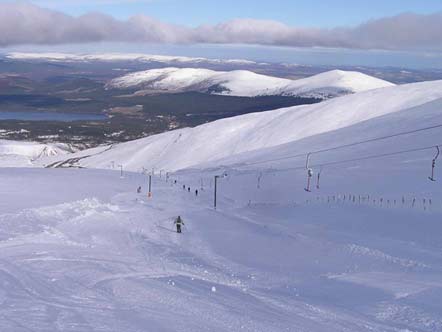
At Christmas time we may have enough snow to open at Cairngorm, but it’s certainly not worth booking an end of year ski trip in September and expecting to get some decent days on the hill. During January, February and March you will usually find that there is at least one of the five centres open for business, but the number and extent at any one time varies greatly. Quite often the best conditions can be found in April and even into May. At this time of year many people take to the Cairngorm plateau for some ski touring as the snowfields up there often last well into summer.
I hiked Glencoe in June a few years back in order to claim some summer turns on the large snow patches which remained. One year the top drag lifts could not be operated at the end of March because they were buried under so much snow. Oh, how we could do with conditions like that again this winter!
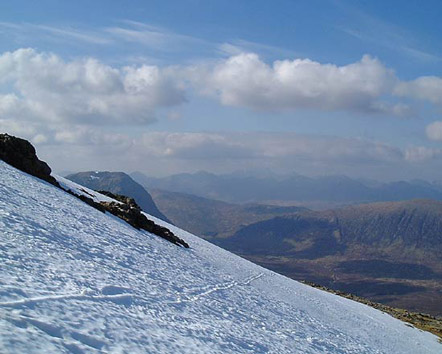
Global warming gets blamed for the recent run of poor winters and although Scotland is farther north than many Canadian ski resorts, our old friend the Gulf Stream ensures that it never gets cold enough to have prolonged spells of low temperatures and snowfall. People are now saying the melting of the polar ice caps might shut down the Gulf Stream, which would mean colder and more severe winters for the UK. Though this might be true, it’s unlikely to come soon enough to allow me the luxury of being able to ride in the Scottish mountains every day from October to June!
When it’s wet and miserable on the Scottish slopes it can feel colder than the Arctic. With a 60m.p.h. wind chill, it’s not uncommon to have temperatures as low as -30C. I well remember when we used to ski race on Cairngorm. There were occasions when it was so windy that the lifts were all closed but this did not mean the race would be cancelled - certainly not. We would walk up to the start gate and race. There has been more than one occasion when I have been poised at the start gate, but on the word “Go!”, as I pushed out, I have been blown back through the start wand! Needless to say, there were some really slow times on days like that.
Scotland has five areas with permanent uplift for winter sports. You will notice that I did not call them resorts. Nevis Range (near Fort William) and Glencoe are in the west while Glenshee, Cairngorm (near Aviemore) and the Lecht are further east.
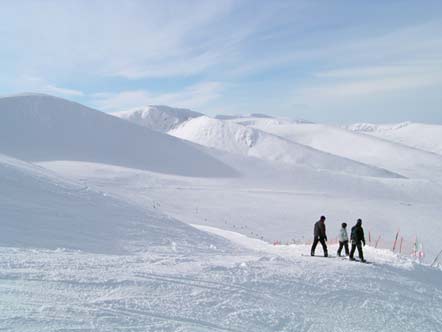
Aviemore
Aviemore, Cairngorm, call it what you want but this is a place I always enjoy returning to and I always get a special feeling in my heart as I drive up the A9 into Speyside. Cairngorm first came to prominence in the 1970s with the building of the Aviemore centre which included hotels, an ice rink and a nightclub. The design of the place left a lot to be desired and as the years passed, the tourist numbers declined, and the area became a bit of an eyesore. However, during its golden years, it was not uncommon to see film stars and other famous people sampling the delights of this small highland town.
Aviemore’s downfall started in the early 1980s when ski holidays to Europe, especially to Austria and Italy, became much more affordable to the average working person. People who normally got their annual fix of snow up in Scotland started to abandon it in favour of better resorts abroad. Now however, Aviemore is working very hard to bounce back: the old centre is being redeveloped and the mountain now has the new funicular railway which can whisk you up to just below the summit of Cairngorm in a matter of minutes.
The Cairngorm ski area is located nine miles from the town of Aviemore, but it’s a lovely drive up to the slopes on a fine clear morning and on passing Loch Morlich the reflection of the Cairngorm Mountains paints a perfect picture on the still waters.
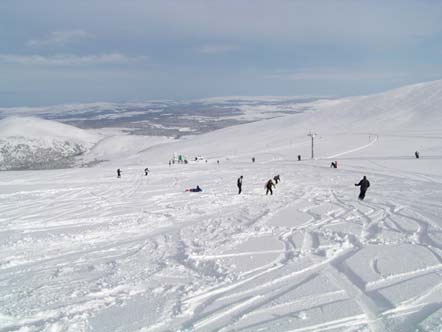
The top Ptarmigan Bowl is a relatively snow-sure basin and an ideal beginners’ area with wide gentle slopes. Just above the top T- bar there are normally a few rails and a big kicker where people sometimes hang out in spring long after the lifts have closed. From the top of the mountain there is good riding (when conditions allow) down the west wall into Coire na Ciste. Unfortunately, it’s now been a few years since I’ve been able to have decent sport down there and in recent winters, snow cover has been very poor.
The main area for riding these days is in Coire Cas which has some wide and reasonably long runs but nothing particularly challenging. The White Lady run down to the Sheiling mid station can also be great fun but often becomes one big mogul field.
Glencoe
The name has so much history attached to it and is a place of outstanding natural beauty. Driving up onto Rannoch Moor always inspires me for a great day’s boarding as you look up towards the head of the glen and stare at Scotland’s best mountain, the impressive Buichaille Etive Mor.
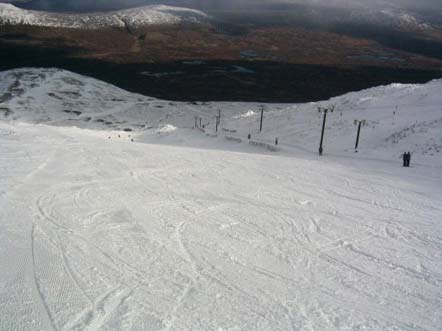
Access to the slopes is via an old chairlift which takes you to the plateau where there are a good selection of easy slopes. The top runs are accessed from two drag lifts after a short trip on a single seater chair. Scotland’s steepest piste, ‘The Flypaper’ is up here and although fairly challenging, it’s not very long. From the top there are several different routes to take and when the snow is good there are plenty of gullies and natural kickers all over the area. On a clear day with good snow cover you can have a lot of fun here. Who needs a snow park! On rare occasions it is possible to ride from the top drag lift all the way back to the car park. Midweek can be quiet here and I have spent some of my best boarding days here in glorious spring conditions with few people around.
Nevis Range
Also called Aonach Mor after the mountain it is perched on, this is Scotland’s newest area and is a year round recreational destination. In the winter there’s skiing, and in summer it becomes a world class mountain biking destination which has hosted World Cup competitions. It is situated a couple of miles north of Fort William in the shadow of Ben Nevis, and on clear days there are spectacular views from the summit of Aonach Mor looking across Carn Mor Dearg to the Ben itself. Access to the slopes is via a gondola from the car park to the Snow Goose lodge where there is a restaurant, shop and bar.
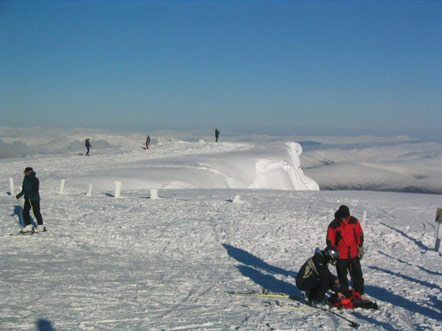
Generally snow cover is good here and it’s a great place for beginners. The summit can be accessed by a chair followed by a long T-bar then finally a button lift. The runs back down are generally quite wide and provide some decent sport with a fairly good vertical drop. Now to the really good part; the most recent addition to the area is the Braveheart Chair which allows access to some great freeride terrain in the back corries. This area is not always open due to bad weather or poor snow but when conditions are good it’s a mighty fine place to be. The steep drop into Coire Dubh puts a lot of people off, but on the good days you feel you could be anywhere in the world.
This area has some steep and challenging terrain and is great after a fresh dump of powder. The only downer after a few hours in the back corries is having to make your way back round to the Snow Goose as it can often have patchy snow and is flat in places, but it’s worth the effort. Also from the top of Aonach Mor it is possible to drop off the back of the mountain into Summit Gully where there is a long off piste run which flattens out as it comes back to the Brave Heart chairlift. The ski patrol can be found in a small hut at the top of the summit Poma tow so if you are not sure about the conditions, just ask them.
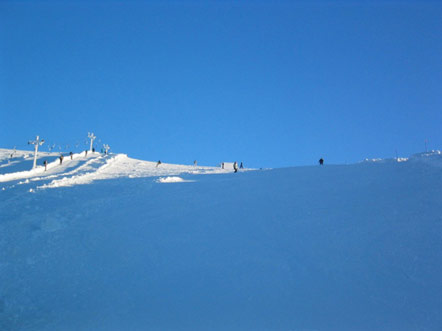
Glenshee
Situated on the A93 between Blairgowrie and Braemar, Glenshee ski area is sometimes referred to as Scotland’s “Trois Vallees”. However, its only similarity is that it is situated in three valleys and covers four mountains. Yes, it has several lifts, but there is nothing else that makes it anything like the French giant! There is plenty of parking along the roadside and it’s quick and easy to get a lift ticket and access the slopes.
Glenshee has the country’s largest lift system with 25 lifts as well as the largest ski-able area with slopes on both sides of the road. On the Cairnwell side there is access to the “Tiger” run which is usually moguled and quite steep but provides reasonably challenging sport whenconditions are good.
During the week the slopes are not usually busy but when there has been a fresh fall of snow and the weather has settled, it seems that many people take a day’s holiday or mysteriously fall ill and call in sick to work! The place to head is Glas Maol (3504ft/1037m). I’ve had a lot of good fun up here in recent years after a dump of snow, but make sure you get up early if you want fresh tracks as it’s normally skied out after a couple of hours.
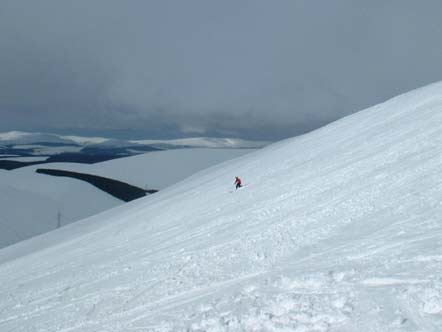
This area has some good natural terrain and plenty of space. Glenshee however, does not seem to hold the snow as well as Cairngorm, Nevis Range or Glencoe, and usually closes its lifts first. Winds also affect the uplift here just like elsewhere in Scotland but it is further east and the strong westerly winds have sometimes eased a little by the time they reach this side of the country.
The Lecht
This is Scotland’s smallest area situated between the villages of Cockbridge and Tomintoul on the road which is often one of the first to be closed by snow in the winter. It’s not uncommon for the area to have full snow cover yet remain closed because it’s stormbound. The Lecht is really only a place to learn as all the runs are short and don’t present much of a challenge. I however, have a soft spot for it, as it was the place where I had my first snowboarding lessons all those years ago. They do have a fun park and it’s even been known for a half pipe to exist here.
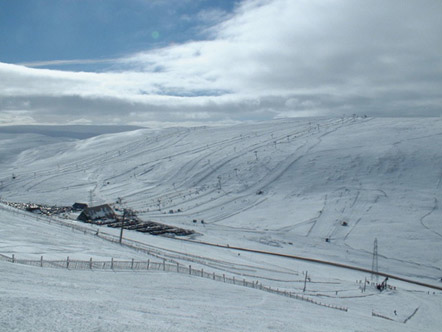
Well there you have it; an insight into what Scotland has to offer in the way of snow. Despite its limitations, if you can get here when the conditions are favourable then you could well be rewarded with some excellent days which will give you memories to last a lifetime. Good highland hospitality with lots of good accommodation make Scotland well worth a visit.
So when is the best time to come to Scotland to snowboard...?
Stuart McWilliam hails from Dumfries, Scotland. He started skiing at age 12 and went on to embrace many forms of snow sport, from slalom to snowboarding to ski touring. He now spends 6 weeks travelling with his wife each year and also visits the Scottish slopes whenever possible. He has contributed to the “Where to Ski and Snowboard” guide books, and his other interests include football, horses, good food and fine wines.
For more information on the Scottish Highlands check highland-instinct.co.uk



























